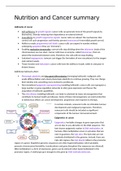Nutrition and Cancer summary
Hallmarks of cancer
Self-sufficiency in growth signals: cancer cells can generate most of the growth signals by
themselves, thereby reducing their dependence on external stimuli.
Insensitivity to growth suppressive signals: cancer cells can subvert the mechanisms that
control cell cycle progression and thereby prevent senescence(=irreversible growth arrest).
Ability to evade programmed cell death: cancer cells can expand in number without
undergoing apoptosis (they are ‘immortal’).
Enabling replicative immortality: normal cells stop dividing when the telomeres (ends of the
chromosomes) are too short. Cancer cells have an enzyme, called telomerase, that can
extend the shortened telomere ends. Therefore, the cells will not stop dividing.
Sustained angiogenesis: tumours can trigger the formation of new vasculature for the oxygen
and nutrient needs.
Tissue invasion and metastasis: cancer cells have the ability to invade, settle in and grow in
distant tissues.
Additional hallmarks 2022:
Phenotypic plasticity and disrupted differentiation (emerging hallmark): malignant cells
evade differentiation and unlock phenotypic plasticity to continue growing. They can change
their identity into something more inclined to proliferate.
Non-mutational epigenetic reprogramming (enabling hallmark): cancer cells can reprogram a
large number or gene-regulation networks to alter gene expression and favour the
acquisition of hallmark capabilities.
The microbiome (enabling hallmark): our body is colonised by many microorganisms that
contribute to human health and disease. Some of these microorganisms can exert protective
or deleterious effects on cancer development, progression and response to therapy.
In certain contexts, senescent cells can stimulate tumour
development and malignant progression. Therefore,
senescent cells should be included as significant
components of the tumour microenvironment.
Epigenetics in cancer
Epigenetics: heritable changes in gene expression that
are not due to any alteration in the DNA sequence. The
best known epigenetic marker is DNA methylation. In
humans, DNA methylation occurs in cytosines that are
next to guanines, the CpG sites. The CpG sites are not
randomly distributed in the genome, instead, there are
CpG-rich regions, the CpG islands (often in the promotor
region of a gene). Repetitive genomic sequences are often hypermethylated, which probably
prevents chromosomal instability, translocations and gene disruption (the sequences are silenced).
DNA methylation is a form of expression, genes can be silenced when hypermethylated in the
promotor region. A methyl group is brought to the gene by DNA methyltransferases.
, During cancer development, those repetitive sequences are often hypomethylated (removal of
methyl groups). This contributes to the development of a cancer cell in three ways:
1. Generation of chromosomal instability
2. Reactivation of transposable elements
3. Loss of imprinting
Undermethylation can favour mitotic recombination, leading to deletions and translocations.
In some cancer cells, CpG islands in the promotor regions become methylated, to, for example,
silence tumour suppressor genes or DNA repair genes. In other cancer cells, the islands become
demethylated to express the normally supressed genes. Epigenetic inactivation in cancer by
hypermethylation occurs in sporadic tumours as well as in inherited cancer syndromes.
Chromatin = complex of DNA and protein. DNA is wrapped around histone proteins, consisting of 4
core histones (H2A, H2B, H3, H4) and 1 linker histone (H1).
Histone modifications occur in different histone proteins and histone residues. Those modifications
involve methylation and acetylation. Histone acetylation (to a lysine) is associated with
transcriptional activation, but the effect of histone methylation depends on the type of amino acid
and its position in the histone tail. Modifications of histones can be mono-, di- or trimethylated,
whereas methylation of the CpG islands can only be monomethylated.
miRNA: short, noncoding RNAs that regulate gene expression by sequence-specific base pairing of
the target mRNA. The result of this base pairing is mRNA degradation or inhibition of translation.
DNA methylation and histone modifications are reversible. It is possible to re-express DNA-
methylated genes in cancer cell lines by using demethylating agents and to rescue their functionality.
Diet-gene interactions
Gene variant: a permanent change in the DNA sequence that makes up a gene. Variants can affect
one or more nucleotides in a gene. Gene variants can be:
Inherited: passed from parent to child and are present throughout a person’s life in virtually
every cell in the body.
Non-inherited: occur at some time during a person’s life and are present only in certain cells.
These variants occur in somatic cells (the inherited variant in germ line cells).
De novo variants: genetic changes that are described as new, the variant is recognized in a child but
not in either parent. In some cases, the variant is present in the egg or sperm cell of the parents, but
not in any other cell.
Mosaicism: variants acquired during development can lead to mosaicism. Here, a set of cells in the
body has a different genetic makeup than other cells, leading to, for example, a dot pattern in cats.
Many variants have no negative effects and can give differences in hair colour, but some can give rise
to certain diseases. Substitution variants can be classified as missense (the nucleotide change results
in the replacement of an amino acid with another amino acid) or nonsense (the altered DNA
sequence results in a stop signal). Variants can occur through insertion, deletion, insertion-deletion,
duplication, inversion, frameshift and repeat expansion.
Gene-environment interactions can be described using different models:
Qualitative models
Statistical models




